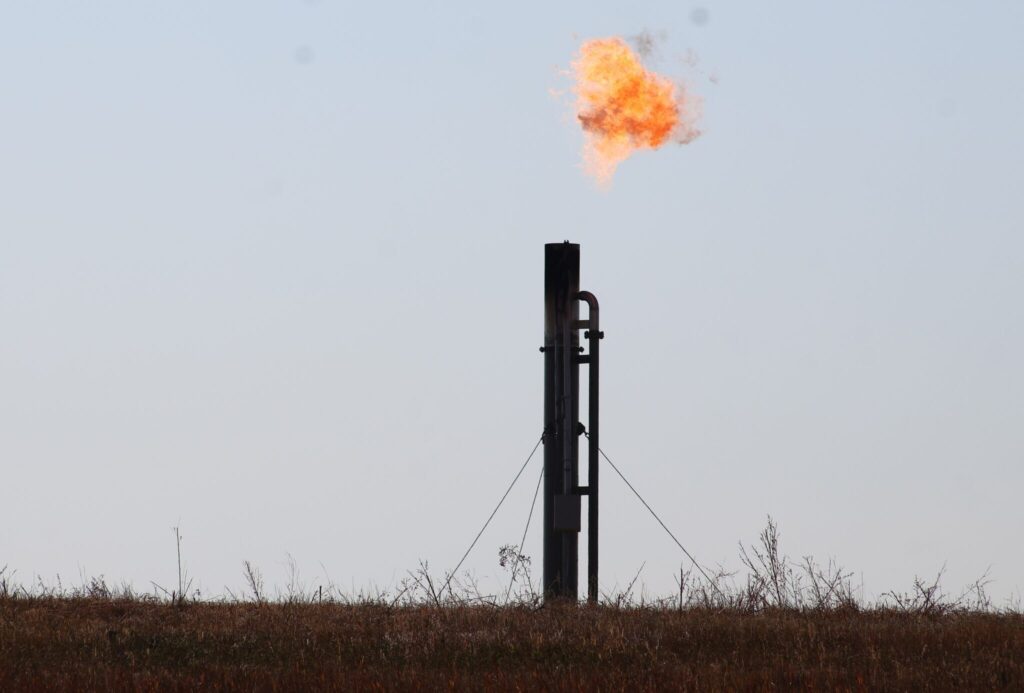Inspired by her grandparents, Tonah Fishinghawk-Chavez proves that caring for the community is an action, not just a word
Wildfires cut into oil production; operators agree to some voluntary restrictions

Oil wells continue to operate near scorched ground south of Watford City on Oct. 9, 2024. (Jacob Orledge/North Dakota Monitor)
North Dakota’s top oil regulator says companies voluntarily agreed to pump less oil to limit fire risk, with more production cuts possible if wildfire conditions worsen.
Wildfires that began Saturday in North Dakota’s oil-producing region have burned an estimated 110,000 acres as of Thursday. Causes of the fires are under investigation. Oil activity has not been linked to the fires, but oil regulators have been part of the statewide response.
State regulators asked oil operators on Saturday afternoon to voluntarily shut down oil and gas wells in areas with high fire danger, said Nathan Anderson, who recently took over as director of the Department of Mineral Resources.
Operators quickly complied with the voluntary measure, with an estimated 300 to 400 wells shut in, according to Anderson.
“When we asked for voluntary shut-ins, a lot of the operators were already in the process of doing that,” Anderson said. “And there’s industry technology that allows operators to do that remotely.”
The voluntary production restriction was lifted early Sunday between 2 and 4 a.m. after winds subsided, Anderson said. Wind gusts had reached as high as 78 mph in northwest North Dakota on Saturday, according to the National Weather Service.
An estimated 125 wells were still not operating as of early Thursday afternoon, Anderson said. Regulators planned to monitor weather conditions Thursday afternoon and into the weekend to determine if additional production restrictions are needed, Anderson said.

About 6% of natural gas produced in North Dakota is flared, or burned off, due to insufficient pipeline capacity and other infrastructure.
Anderson said the Department of Mineral Resources does not have any information that a flare caused any of the fires.
“But we understand this is a typical first assumption,” he added.
Oil operators are required to keep flares lit at oil and gas wells and natural gas plants to prevent natural gas from being vented into the air, said Jim Semerad, director of the Division of Air Quality for the Department of Environmental Quality.
If a well is shut in, there is no need for a flare.
The Department of Environmental Quality, which regulates flaring at natural gas plants, contacted operators Monday to encourage them to report any issues caused by the wildfires.
Oil production on Thursday was estimated to be down about 60,000 to 90,000 barrels per day due to wildfires, according to Justin Kringstad, director of the North Dakota Pipeline Authority. Earlier in the week, production may have been down more than 100,000 barrels per day, Kringstad estimated.
Official October oil and gas production numbers won’t be available until December. North Dakota produces just under 1.2 million barrels of oil per day from about 19,000 wells, according to the most recent figures.
The state fire marshal is investigating four fires – two in Williams County, one near Keene and one near New Town.
Investigators do not have any indication at this time that oil facilities contributed to any of the fires, but no causes have been ruled out, State Fire Marshal Doug Nelson said.
“We’re still looking at all the possible ignition sources that would be available and the fuels that are in those areas,” he said.
Nelson said he was not familiar with the steps the oil industry was taking to minimize fire risk, but he advocates for responding to the extreme conditions.
“This is something that we have seldom experienced before in North Dakota, and definitely something that warrants changing our behaviors, if we can help reduce the impacts,” Nelson said.
Federal agencies are investigating the causes of the Elkhorn Fire south of Watford City and the Bear Den Fire on the Fort Berthold Reservation.
McKenzie County Emergency Manager Karolin Jappe said the larger oil and gas operators have cooperated amid the dangerous conditions. She said it’s the smaller operators that can make her nervous, and she did report this week a flare surrounded by weeds that she was concerned about. Jappe said she got an immediate response from a regulator that it would be taken care of.
McKenzie County rancher Lynn Heiser, who has been affected by the wildfires, said he hopes there can be meetings in the future with state and county leaders, the oil industry and farmers and ranchers to discuss what can be done differently. He said he’s not assigning any blame, but he questioned whether some oil sites could have natural gas flares repositioned to decrease the fire risk.
“Prevention is the key,” Heiser said.
External
The billboard project is expanding to Oregon
Identification not yet made
Indigenous participation may be highest in the climate conference’s history
Dramatic play reveals power of Indigenous stories and community
Thousands peacefully protest






